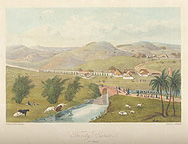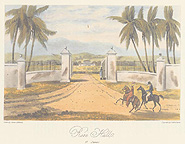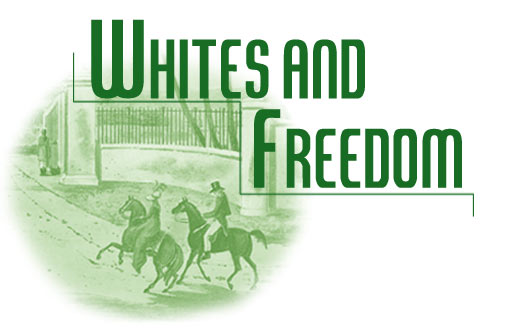
From the perspective of the Caribbean plantation owner, the 1700s were
the golden age. They were kings
of their manor. They ruled omnipotently
over their slave subjects as, “men who raised themselves from poverty
to affluence and who reclined in the lap of luxury, in tropical ease.”
There were no rules governing how they treated their slaves, so planters
had free reign to instill the respect of their authority through fear
of punishment. And that’s exactly what they did.
Some claimed that at  the
time they were opposed to how violently slaves were treated, but couldn’t
voice their true thought. Many
though, thought that slaves were lesser human beings with more in
common with horses than men. If the 1700s were the golden age for
plantation owners, then the 1800s would be for many their Dark Age.
Traveler Mrs. Carmichael described the changing planter’s life
style by saying, “The affluence which once existed in some degree,
is to be found no more.”
[1]
They lost their ability to reign as little kings;
people began to stand up for the ex-slaves’ rights. The lives of the plantation owners were forever
changed by emancipation. These
changes could be seen as early as the period of apprenticeship, which
lasted in the British colonies from 1834 until 1837 and 1838. the
time they were opposed to how violently slaves were treated, but couldn’t
voice their true thought. Many
though, thought that slaves were lesser human beings with more in
common with horses than men. If the 1700s were the golden age for
plantation owners, then the 1800s would be for many their Dark Age.
Traveler Mrs. Carmichael described the changing planter’s life
style by saying, “The affluence which once existed in some degree,
is to be found no more.”
[1]
They lost their ability to reign as little kings;
people began to stand up for the ex-slaves’ rights. The lives of the plantation owners were forever
changed by emancipation. These
changes could be seen as early as the period of apprenticeship, which
lasted in the British colonies from 1834 until 1837 and 1838.
The 1800’s saw the gradual evolution of emancipation sweep
across the islands of the Caribbean even before it reached the United States. Britain was one of the catalysts in this
process by first abolishing the slave trade in 1808. They proceeded to regulate slavery in their
own colonies, imposing limits on punishments and requiring planters
to register their slaves so that the government could keep track of
births and mortality. Planters
were upset by the fact that a government across the ocean was creating
the rules and regulations by which they had to live.
Many plantation owners would see their empires shrink in a
single lifetimes.
Still, the British government tried to tailor its approach
to emancipation based on what it believed its island planters needed.
Islands saw varying degrees of speed and success in the process of
the initiation emancipation. For
many Caribbean islands apprenticeship was the steppingstone
between slavery and freedom for oppressed Africans. Antigua was one of the few British islands
that skipped the apprenticeship process. Others, like Jamaica and Barbados, went through the transitional period
of apprenticeship. This was
intended to preserve the planters’ access to a stable labor force,
while also ending slavery and instructing the ex-slaves and ex-masters
in the system of free wage labor.
The first step that affected the lives of plantation owners
was the abolition of the slave trade.
Although the illegal slave trade persisted, slave owners were
forced to ameliorate treatment of their slaves because the never-ending
supply began to dwindle. Thus plantation owners had to reduce punishments
and improve food and other aspects of slaves’ conditions.
Later, as talk of emancipation began to gather strength, there
was another push for slave owners to treat their slaves better. English planters did not want to be made a public
spectacle back in England for their mistreatment of slaves,
and thus further emancipation’s cause.
At the same time, they resented the loss of total control over
the bodies of those whom they claimed as slaves. As the push for abolition
of slavery grew, planters believed that their own rights were shrinking.
They could no longer inflict punishment on their slaves for any reason
they pleased, to any degree that they desired, and after apprenticeship
began in 1834, they could no longer inflict physical punishment at
all. Special magistrates were sent from Britain to undertake the responsibility for
punishing unruly apprentices and masters.
Before emancipation slave owners feared that less severe
punishments would lead workers to greater disobedience. They feared
that eventually it would lead to uprisings. Yet after emancipation,
many no longer feared insurrection.
British traveler James Thome quoted
a planter as saying, “it was feared before abolition, but now no one
thought of it.”
[2]
Planters believed that revolts were no longer an
issue because the former slaves were now more free and well treated,
therefor happier.
Revolts did, however, still occur. Morant Bay, Jamaica, was in 1865 the epicenter of one
such revolt. Blacks protested
their unfair treatment outside a courthouse in Morant Bay. The protest eventually involved
more than 300 people; plantations were burned and some were killed.
Planters had opposed emancipation, in part, because they
believed that it would destroy their profit margin. They used economics to defend the need for slavery.
They believed that they would be unable to afford to pay ex-slaves
for work that they had previously done free.
The change would severely hurt planters’ income.
After the initiation of freedom many changed their mind and
determined that emancipation may even be better than slavery.
Others could not accept that slavery was over.
They either refused to employ ex-slaves, except at the most
menial wages, and under the most slave-like conditions, or they petitioned
the British government for new imports of indentured workers from
Africa and Asia.
Apprenticeship was created as a middle ground between slavery
and complete emancipation. The idea was to improve working conditions
for ex-slaves, grant them wages, and some degree of choice of work. Under apprenticeship planters were required
to pay wages to their slaves. Planters
received some compensation but it was poorly distributed and quickly
squandered. Wages were not high, and planters frequently balked at
actually paying them. In practice apprenticeship was often little
more than light slavery. Yet
again, after the beginning of apprenticeship, some planters changed
their minds and became supporters of the new system.
One planter interviewed by James Thome
went as far to say “we (planters) are now rejoiced that slavery is
abolished.” Some believed that,
“wages are found to be an ample substitute for the lash.”
[3]
wages, and some degree of choice of work. Under apprenticeship planters were required
to pay wages to their slaves. Planters
received some compensation but it was poorly distributed and quickly
squandered. Wages were not high, and planters frequently balked at
actually paying them. In practice apprenticeship was often little
more than light slavery. Yet
again, after the beginning of apprenticeship, some planters changed
their minds and became supporters of the new system.
One planter interviewed by James Thome
went as far to say “we (planters) are now rejoiced that slavery is
abolished.” Some believed that,
“wages are found to be an ample substitute for the lash.”
[3]
Magistrates
were appointed in order to defend former slaves’ rights. They were designed to regulate planters’ treatment
of their apprentice workers. It’s
questionable how effective these magistrates really were:
“Some
were intelligent and sincere, others were disinterested and not so
bright; some were won over by the planters and others leaned too far
backwards to protect the apprentices”
[4]
Planters still managed to get around magistrates’ rulings.
One way was described by Special Magistrate J.B. Colhurst:
“To charm and flatter
a man on his arrival, and laud him to the skies, is a common practice,
but the moment they find him not purely their own, they lose no opportunity
of annoying him in every possible way.”
[5]
Some
planters and masters continued mistreating slaves regardless of magistrates’
rulings. Magistrates sometimes corrupt or really did not care for
the well being of apprentices. James A. Thome
wrote that Colhurst, who claimed to be fairer than many, “showed a great and inexcusable partiality for
the masters.”
[6]
Free people still faced biased treatment, and planters
still found means of punishing them for disobedience. Flogging which
had been common practice by planters was now only to be used for extreme
disobedience. Some of the planters in Barbados and Antigua applauded this concept, but only
after it was initiated. Thome described how the coming of emancipation made some planters
feel relieved: “Emancipation has freed us (planters) from the painful
task of flogging!” Still others continued taking punishment into their
own hands because they knew of no other way to control workers. Thome
described managers as “many of the former are ignorant, degraded men,
who know how to govern only by the whip.”
[7]
Colhurst said that he
did not support the harsh punishments still inflicted by manager on
slaves. He said that he would, “permit no man to inflict
upon apprentice any act having the semblance of punishment.” He goes on to say that, “those gentlemen cling
to habits contracted by slavery, which the jealousy of their lost
authority fosters up.”
[8]
Apprenticeship
was still considered by many to be ineffective or unnecessary. Critics said that planters did not do anything
to prepare apprentices for their eventual freedom. Some planters remained upset that there was
no longer slavery. Another problem they had with apprenticeship was
that they were required to minimize hours that former slaves could
work. Former slaves could work no more than forty hours a week, and
only from dusk till dawn. One such policy was adopted in Jamaica; “according to the abolition act
the Jamaica apprentices were bound to give 40
½ hours or free labor to their owners every week.”
[9]
Planters disapproved of this regulation because
prior to apprenticeship slaves worked the fields and processed sugar
twenty-four hours a day. They believed that not allowing this would also
greatly cut in to profit margins. They managed to get around the limitations
of the work week by paying apprentices for anytime over the required
40 and ½ hours.
Emancipation
was received with mixed results among planters. Many plantation owners
still managed to work their way around the limitations of apprenticeship. Some of the benefits of apprenticeship weren’t
followed. It was essentially glorified slavery. Other planters became proponents of emancipation
and were able to adapt, though they often had to cut back the number
of slaves they had and the amount of land they cultivated. Plantation owners would never again be Kings
of their land, at least not through constant physical force and the
threat of punishment. Unable
to exert the same kind of power over others, they would themselves
never feel the same
[1]
Quotes from Mrs. A.C. Carmichael, Domestic Manners
and Social Condition of the White, Coloured,
and Negro Population of the West Indies,
(London, 1834), 16.
[2]
James Thome, Emancipation in the West Indies:
A Six Months’ Tour in Antigua,
Barbados,
and Jamaica
in the Year 1837, (New York, 1838), 274.
[4]
Apprenticeship and Emancipation.
Mona, Jamaica
: Dept. of Extra-Mural Studies, University of the West
Indies. Pg 6
[5]
John B. Colthurst, The Colthurst Journal:
Journal of a Special Magistrate in the Islands of Antigua and St.
Vincent, July 1835-September 1838, ed. Woodville K. Marshall,
(Millwood, N.Y., 1977), 68.
[7]
Thome, quotes from 198 and 265.
[9]
Apprenticeship and Emancipation, 6
|

